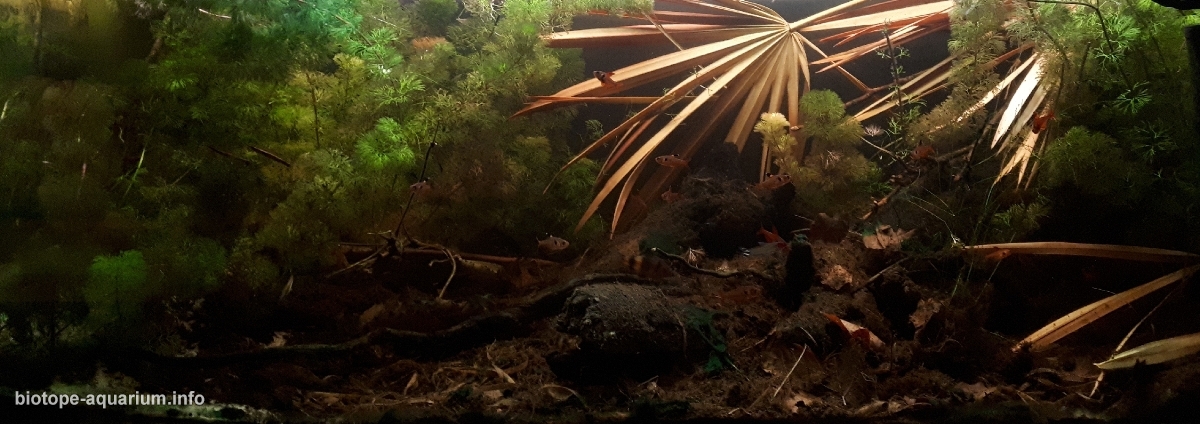Shallow pond, Moriche palm oasis, Rio Morichal Largo, Venezuela
41th place in Biotope Aquarium Design Contest 2019
Poland. Łukasz Kułakowski

Volume: 200 L
Dimensions: 100x40x50 cm
List of fishes: Nannostomus eques
Hyphessobrycon sweglesi
Apistogramma hongsloi
Hemmigramus rodostomus
List of plants: Cabomba aquatica
Eleocharis sp
Description of decorations: To decorate my aquarium I used a large amount of dry palm leaves, which I placed on the back wall. The substrate is white quartz sand mixed with a lot of peat, leaves and pieces of twigs. in the central part you can see large pieces of wood that are also a refuge for fish. The whole undergoes partial decomposition creating a natural carpet.
Description of equipment: the filtration is covered by an internal filter with containers for ceramics, hence biological filtration. Lighting is two t5 lamps with two colors. 6500k and 8500k. the thermostat heater is responsible for the temperature.
Water parameters: Temp. 24°C
Conductivity 40uS
Hardness 1>
Ph 5.9
Additional info: in my tank I make a water change every two weeks. 15 percent RO water. I check the quality of the parameters on a regular basis to avoid a large jump, eg ph
INFORMATION ABOUT BIOTOPE
Description of the area surrounding the biotope: River Morichal Largo with an approximate length of 200 kilometers linear and
maximum width 20,5 m, belongs to the Orinoco basin and is located south of Anzoátegui and the state of Monagas between 9 ° 30 8 8 ° 25 ‘N and 63 ° 45’
62 ° 20’0. Its source is located
at an approximate height of 160 m m.n. and 5 km east of Morón Place in the
Motorway El Tigre-Ciudad Bolívar. He rushes in to Caño Mánamo, establishing
Geographical boundaries between the state of Monagas and the state of the Delta Amacuro. This river together
with Yabo and Tigris are the main tributaries.
The dominant climate in this region is warm and rainy, with temperatures from 26 ° to 30 ° C and 82% relative humidity.
Rainy season (May – December). Dry season (January-May).
The pH values ranged from 4.6 to 6.6;
the conductivity showed slight seasonal and longitudinal variability, 15 and 30 μs / cm
and growing in the rest of the river
up to 65 μs / cm. the most important source of moisture are
morichales oasis.
Description of the underwater landscape of the biotope: the underwater landscape is nothing like a lot of decaying plant remains, tree leaves, and large leaves of a wine palm (Mauritia flexuosa). under the water we can see the grass and Cabomba grasses that grow over the banks and come down below into the water. This vegetation works well in sour and soft water. They give shelter to many. species of smaller freshwater fish. It is worth mentioning that the substrate that is covered with such a dark litter of leaves makes an impression that the river was black water
Description of the parameters of the habitat: Water is very clear but looks brown.
Temperature of river it is 26-30°C
Conductivity is 30-65uS
Ph 4.8-6.9 depends of season
List of fishes and invertebrates occurring in the nature biotope: Apistogramma guttata
Apistogramma hongsloi
Nannostomus eques
Hyphessobrycon sweglesi
Hemmigramus rodosthomus
List of plants found in the nature biotope: Cabomba aquatica
Eleocharis sp.
Threats to the ecology: The aquarium presents a water environment that may soon cease to exist. right now the riverbed dries practically and this is caused by the urbanization of the area. exactly expanding communication routes. we can never see these beautiful Swegles in nature again, that’s why I created them a piece of their Morichal largo
Sources of information:
https://drive.google.com/file/
https://drive.google.com/file/
